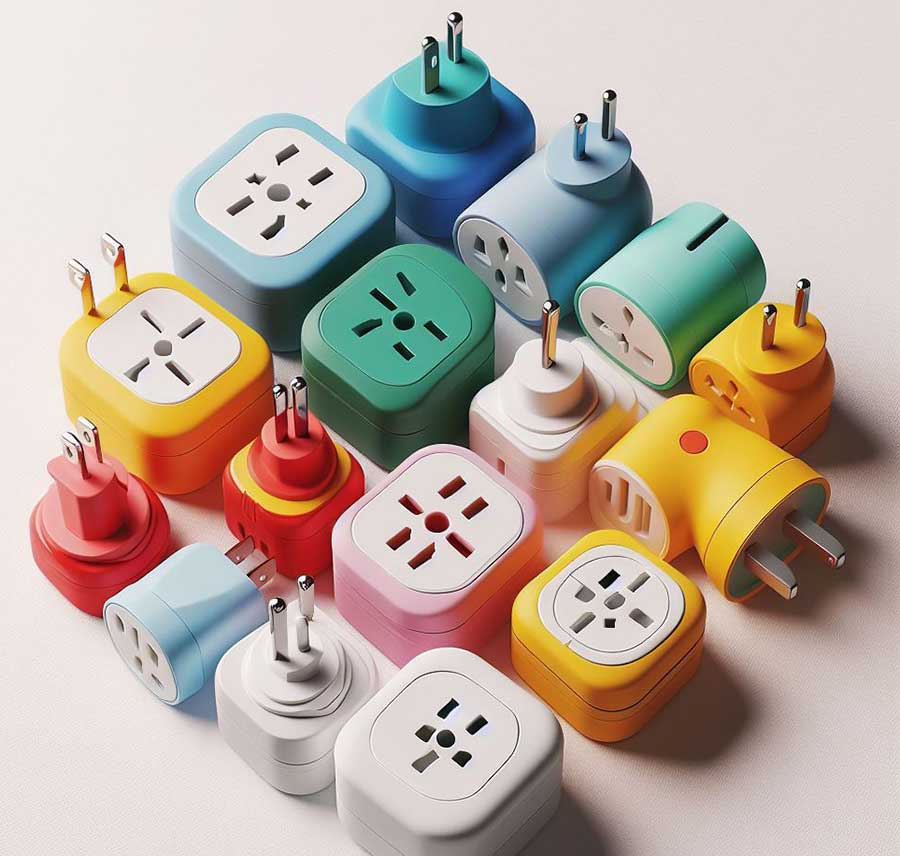Have you ever found yourself frustrated with a travel adapter that just won’t cooperate? Understanding the intricacies of these small devices can make a big difference in your travel experience.
From voltage compatibility to plug types, there are various aspects to consider when choosing the right adapter for your trip.
Stay tuned to uncover the essential secrets that will ensure you never face a charging dilemma again.
Understanding Voltage and Plug Types
Confused about which travel adapter to use overseas? Understanding voltage and plug types is crucial for a smooth travel experience. Different countries have varying electrical standards, so it’s essential to choose the right adapter to ensure your devices work safely.
Start by checking the voltage of your destination; some countries operate on 110-120 volts, while others use 220-240 volts. Using electronic devices with the wrong voltage can lead to damage or even safety hazards.
Next, familiarize yourself with the plug types commonly used in the region you’re traveling to. There are multiple plug configurations worldwide, such as Type A, Type C, Type G, and more. Make sure your adapter is compatible with the outlets in your destination country to avoid any connectivity issues.
Additionally, some adapters come with built-in surge protectors to safeguard your devices from power fluctuations. Understanding these basics will help you select the right travel adapter and stay connected wherever you go.
Types of Travel Adapters
To ensure seamless compatibility with electrical outlets overseas, understanding the different types of travel adapters available is key.
There are primarily four main types of travel adapters: Type A, Type B, Type C, and Type D. Type A adapters are commonly used in North and Central America, Japan, and some parts of South America.
Type B adapters are also prevalent in North America but offer an additional grounding pin. Type C adapters are commonly used in Europe, South America, Asia, and Africa, featuring two round pins. Type D adapters are specific to India, offering three round pins in a triangular pattern.
It’s essential to choose the right type of travel adapter based on your destination to ensure a secure and efficient connection between your devices and the foreign electrical outlets. Understanding these variations will help you select the appropriate adapter for your travels, avoiding any inconvenience or potential damage to your electronics.
Universal Vs. Specific Adapters
When selecting a travel adapter, it’s crucial to understand the differences between universal and specific adapters to ensure compatibility with various electrical outlets around the world.
Universal adapters, as the name suggests, are designed to work in multiple countries as they come with different plug configurations that can be adjusted to fit various outlet types. These adapters are versatile and convenient for travelers visiting different regions.
On the other hand, specific adapters are tailored for use in a particular country or region. They’re usually more compact and designed to fit the specific outlets of that area perfectly. Specific adapters are great for travelers who frequently visit the same destination or for those who want a simpler, more compact option.
When choosing between universal and specific adapters, consider your travel habits and destinations to determine which type will best suit your needs and provide the most convenience during your trips.
Researching Your Destination’s Requirements
To effectively prepare for your travels, understanding the specific electrical requirements of your destination is vital when selecting the appropriate travel adapter. Different countries have varying plug shapes and voltages, so researching these details beforehand can save you from inconveniences during your trip.
Start by checking the type of power outlets used in your destination to ensure compatibility with your devices. Some countries may use Type A outlets with two flat parallel prongs, while others might utilize Type C with two round prongs. Additionally, be aware of the voltage requirements as using a device designed for a different voltage can damage your electronics or pose a safety hazard.
Consulting online resources such as government travel websites or forums can provide valuable insights into the electrical standards of the country you plan to visit. Remember that being well-informed about your destination’s electrical requirements will help you select the right travel adapter and ensure a smooth and hassle-free experience during your travels.
Safety Features to Look For
When selecting a travel adapter, prioritize safety features such as surge protection and child safety mechanisms to safeguard your devices and prevent accidents while traveling. Surge protection is crucial in preventing voltage spikes that could damage your electronics. Look for adapters with built-in surge protection to ensure your devices are safe from power surges common in some countries.
Additionally, some adapters come with child safety shutters that provide a barrier between the electrical components and curious little fingers, reducing the risk of electrical shock. These shutters only open when all the prongs are inserted simultaneously, making them a great safety feature for families traveling with children.
Always check for safety certifications like CE or RoHS to ensure the adapter meets international safety standards. Prioritizing safety features in your travel adapter choice won’t only protect your devices but also provide you with peace of mind during your travels.

Compact and Lightweight Designs
For travelers seeking convenience in their accessories, consider travel adapters with compact and lightweight designs for effortless portability without compromising functionality. These adapters are designed to be sleek and easy to carry, fitting neatly into your luggage or even your pocket. Look for models that are specifically crafted to be compact, with foldable prongs or a slim profile. The lightweight nature of these adapters makes them ideal for those constantly on the move, whether you’re hopping between countries or simply moving around within the same destination.
When selecting a compact and lightweight travel adapter, pay attention to the materials used. Opt for durable yet lightweight plastics or metals that can withstand the rigors of travel without adding unnecessary bulk to your bag. Additionally, ensure that the adapter is designed for the regions you’ll be visiting, as different countries have varying plug shapes and voltages. By choosing a compact and lightweight design, you can streamline your travel gear and make staying connected a breeze.
Dual Voltage Devices
Discover the versatility and practicality of dual voltage devices for your international travels. Dual voltage devices are a game-changer when it comes to packing for trips abroad. These devices are designed to work with both 110-120V and 220-240V electrical systems, making them ideal for use in various countries with different voltage standards. When using a dual voltage device, you can simply switch the voltage settings to match the power supply of the country you’re in, eliminating the need for a voltage converter.
One of the most common dual voltage devices is the travel hairdryer. Instead of struggling with hotel dryers that may not meet your standards, bring along your own dual voltage hairdryer for a consistent styling experience wherever you go. Other popular dual voltage devices include laptops, cameras, and phone chargers. Always remember to check that your device is indeed dual voltage before plugging it in abroad to avoid any potential damage.
With dual voltage devices, staying powered up during your travels has never been easier.
Adapting to Uncommon Outlets
To effectively adapt to uncommon outlets during your international travels, understanding the specific plug types and voltage requirements of different countries is essential. Different regions around the world utilize various outlet configurations, such as the Type G in the UK, Type I in Australia, or Type D in India. These outlets may not be commonly found in your home country, so having the right travel adapter is crucial for keeping your devices powered up.
When traveling to countries with uncommon outlets, it’s important to research and acquire the appropriate adapter beforehand. Some adapters are versatile and can work in multiple regions, while others are designed for specific countries. Make sure to check the voltage requirements of your destination as well. Some countries operate on 220-240 volts, while others use 100-127 volts. Using devices with the wrong voltage can lead to damage or even safety hazards.
Adapters for USB Devices
When encountering USB devices during your international travels, ensuring you have the right adapters can make all the difference in keeping your electronics charged and ready to use. USB devices are prevalent in today’s world, from smartphones and tablets to cameras and portable speakers. To charge these devices while abroad, it’s crucial to have the appropriate USB travel adapter. These adapters typically come with multiple USB ports, allowing you to charge several devices simultaneously.
When selecting a USB travel adapter, make sure it’s compatible with the voltage of the country you’re visiting to avoid damaging your devices. Additionally, consider the type of USB cables your devices use (e.g., USB-A, USB-C) to ensure the adapter matches your needs. Some USB adapters also offer fast charging capabilities, which can be handy when you’re in a hurry.
Having a reliable USB travel adapter in your travel kit can save you from the hassle of finding compatible charging stations or dealing with low battery levels while on the go.
Tips for Trouble-Free Charging
For a seamless charging experience during your travels, prioritize using high-quality USB cables that are compatible with both your devices and the USB travel adapter. Opt for cables that support fast charging if your devices are compatible, as this can significantly reduce charging times. When plugging in your devices, ensure that the connections are secure to avoid intermittent charging or potential damage to your gadgets. It’s also advisable to pack an extra USB cable as a backup in case one gets lost or damaged during your trip.
To maximize the efficiency of your charging setup, consider investing in a USB hub or multi-port USB charger. These can be particularly handy if you have multiple devices to charge simultaneously. Additionally, be mindful of the power output of the USB ports on the adapter to ensure they meet the requirements of your devices for optimal charging speed. By following these tips and using reliable charging accessories, you can enjoy trouble-free charging throughout your travels.
